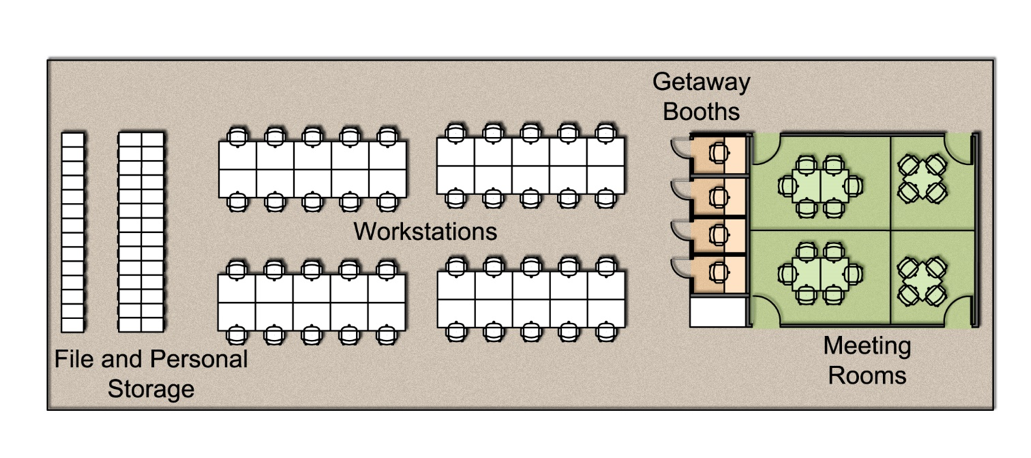As we all know, the open office is the latest design trend. It aims to reduce space per person while promoting mobility and collaboration. However, is there a point when density overtakes productivity to shrink the space footprint? I think there is.
Given all the adverse findings attributed to the open office, the density and space utilization issue must be cut and dry. Open layouts comprise around 70% of U.S. offices. The concerns attributed to the open office include an increase in anxiety due to overstimulation and the lack of privacy, an increase in sick days, feelings of space “homelessness,” and reduced productivity.
Jacobs Workplace Strategies performed an exciting study on density, concluding that a “sweet spot” represents the minimum amount of space per person. The study concluded that there should be a minimum of 125 to 135 usable square feet per work seat with a minimum of 5-foot-long work surfaces to provide adequate personal space in a typical office environment.
I think Jacobs does an excellent job at specifying the minimum amount of space per person, but a healthier amount is a minimum of 150 usable square feet per person.
How Low Can You Go?
In my 30+ years in facilities planning, I have seen clients with over 2,000 usable square feet per person and 90 usable square feet per person. We can agree that 2,000 square feet is too much. But is 90 square feet too small?
I recently visited an office that had a utilization rate of 90 square feet per person. When I entered the office, a manager proudly proclaimed that they had recently reduced space from 250 usable square feet per person to 90. This generated considerable cost savings on their lease with a return on investment of less than one year after project completion. One prominent observation: the space felt cramped with furniture, and the people were “sitting on top” of each other.
For example, the layout below presents a 40-person office with 90 square feet per person, which is cramped.

In the office I visited, employees had to go out into the hallway to make private phone calls. Everyone was so close that employees could overhear conversations taking place in the “getaway booth” conferencing facilities.
The second thing I noticed was that there were many empty workstations. When I asked why, the manager proclaimed they had an active telework policy, and many employees elected to work out of the office. When the office was at 250 usable square feet per person, I asked the question: did people telework as frequently? He replied that they did not but that telework was promoted throughout the space reduction project and had become much more commonplace when they occupied the new space. Teleworking became more prevalent because nobody wanted to come to work in such a cramped environment, which leads me to my next point.
Teleworking to Escape the Office
I have witnessed a trend in office space – sort of the antithesis of the Field of Dreams: “Build it, and they will come.” The new saying might be, “Take it away, and they will go.” As the space per person shrinks, offices can become too stifling to work in. Every conversation is a distraction, and privacy is a rare privilege. To reduce the need for space, organizations now promote enhanced teleworking to provide employees the flexibility and freedom to balance work and home life better.
While I am a huge proponent of working from home (I have been doing so for over 30 years), some people are missing the point. It is one thing to choose to work from home and another to be “forced” out of the office because of distractions and discomfort. People are starting to come into the office the bare minimum that policy allows; instead, they are working at home more. Thus, the investment in open and collaborative space becomes worthless if it does not enable us to share ideas, collaborate, and connect people who would not usually work with each other in an enclosed office environment.
How Many Sardines Can Fit in the Can?
In another office I visited, management was very strategic about planning new open office space, but the result was similar. After completing a project to consolidate two leases into one smaller space, the office operated in the new space for some time and noticed that people were telecommuting more frequently and there were still many unoccupied workstations.
So, they added another division of people to the open office space. Initially, the office was packed and utilized. But, over time, the workstations became empty again. They repeated the process and had the same results. The more people they packed into the space, the higher the percentage of employees who left the office to telework.
Where they once had around 120 people working in 34,000 usable square feet divided between two buildings, they ended up with nearly 350 people working from 15,000 usable square feet. That would be around 43 usable square feet per person if everyone showed up to work in the office simultaneously. (Also, do you know if anyone is concerned about fire code violations?)
In doing this, the office went through a fair number of challenges, from increased employee turnover to communication difficulties that hampered productivity.
What Should the Minimum Space Per Person Be?
Based on my experience, the minimum should be 150 usable square feet per person. This volume of space allows for adequate circulation within the office and a fair complement of collaboration spaces, focused spaces, and informal areas.
The layout below presents another 40-person office design with 150 square feet per person. Comparing this to the 90 square feet per person layout above, it is clear that the office allows for much more circulation and spacing of office activities. Such a space offers an opportunity to create zones for quiet versus more collaborative locations. Files and informal meeting areas can be placed between zones to break up neighborhoods or spaces within the office.

Consider Employee Comfort
Much of the office space in the United States has moved to an open office layout. Technology has enabled us to be more mobile and dedicated, and let’s face it – enclosed private offices often sat vacant and cost too much money to maintain and rent. The open office has become a solution to reduce the amount of space per person and ensure fuller occupancy. However, changing from a traditional to an open office is a significant transformation for an organization that influences culture and work practices. This transition requires change management and communication, which often do not happen enough in space transition projects.
When organizations seek to reduce space to the bare minimum, they often focus on the bottom line of space costs rather than on the more significant costs associated with employee satisfaction, turnover, and productivity.
150 square feet per person still allows for zoning and separation within the office and allows employees to circulate within the space. To achieve the benefits of connectivity and collaboration promoted by open office design, it is important to provide enough space for people to feel comfortable coming into the office and have the office layout support work activities. Packing sardines into a can will not accomplish this objective.










.jpg)


.jpg)
.jpg)
-1.jpg)
.jpg)
.jpg)
.jpg)
.jpg)
.jpg)

